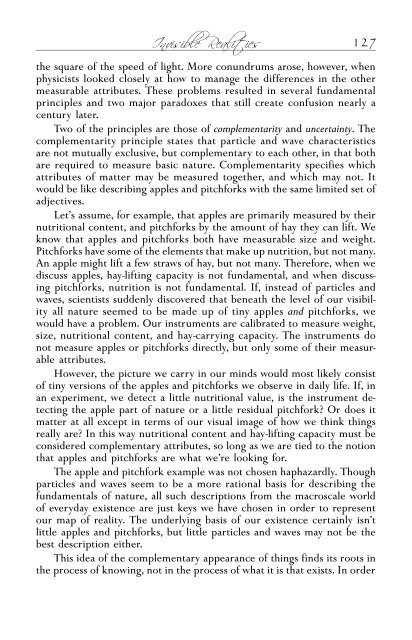edgar-mitchell
edgar-mitchell
edgar-mitchell
You also want an ePaper? Increase the reach of your titles
YUMPU automatically turns print PDFs into web optimized ePapers that Google loves.
64<br />
The Way of the Explorer<br />
this seven-minute task. In the “morning” it was again business as usual,<br />
without a second thought of the experiment.<br />
After three days, during which we traveled more than 240,000 miles<br />
and slowed into lunar orbit, Al and I climbed into the lunar lander, bid<br />
farewell to Stu, and prepared to undock. Stu deposited us in the 10-mile<br />
orbit from which we would descend to the surface, and returned through<br />
the vacuum to a 60-mile orbit for his work of mapping that barren world.<br />
As Al and I orbited only a few thousand meters above the highest lunar<br />
peaks, the familiar gray landscape became recognizable. In a most austere<br />
way, it was hauntingly familiar. There were mountains and valleys, a sun in<br />
the sky. For the first time in three days there was a relative up and down;<br />
the tiny earth in the distance appeared a satellite of the moon. But little<br />
else resembled anything we had ever seen. No flora, no softening features.<br />
Here the land was presided over by an omnipresent night sky. Without an<br />
atmosphere, sunlight lent an unreal clarity to the landscape. If we were to<br />
open the hatch, it seemed as though we could reach out and run our fingers<br />
over the ragged lunar surface.<br />
As for our the mission, there was a tentative sense of optimism. We<br />
knew we were over the right area because we could see Cone Crater and<br />
the entire topography of Fra Mauro beneath us coming into lunar sunrise,<br />
just as we had imagined it would appear out the window of Antares. Then I<br />
was struck with a sense of wonder. The same sun rose this morning over<br />
the Atlantic, I thought, as we silently flew over this strange world.<br />
As we flew through the terminator into the lunar night, barely 90<br />
minutes from beginning our powered descent to the surface, trouble arose<br />
once again. The computer guidance software, we discovered, was receiving<br />
incorrect information, thereby producing a signal that would abort the<br />
landing once it began. Moreover, we would soon be passing behind the<br />
moon into a communications blackout, cutting off our lifeline of information<br />
and support from Houston. Once again, we had to carefully, accurately,<br />
and quickly find a way to bypass a problem that threatened the<br />
mission. But of the 90 minutes available to us to solve the problem in this<br />
case, we would be behind the moon and out of radio contact for 60.<br />
In Houston, where it was 2 o’clock in the morning, they were working<br />
on the problem. When we emerged from behind the moon, we expected<br />
they might have procedures for a fix prepared for us, likely a revised computer<br />
update to get around the problem. But it was much more than that.<br />
After regaining communications we would have but a stark 10 minutes to<br />
complete the pre-descent checklist, enter navigation updates, and manually<br />
program the remedy into the computers. Because of fuel constraints,<br />
time was not on our side. We simply could not afford another trip around<br />
this rugged world without major changes in our cramped schedule.


